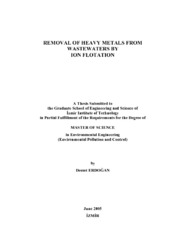Please use this identifier to cite or link to this item:
https://hdl.handle.net/11147/3223Full metadata record
| DC Field | Value | Language |
|---|---|---|
| dc.contributor.advisor | Polat, Hürriyet | - |
| dc.contributor.author | Erdoğan, Demet | - |
| dc.date.accessioned | 2014-07-22T13:51:07Z | - |
| dc.date.available | 2014-07-22T13:51:07Z | - |
| dc.date.issued | 2005 | - |
| dc.identifier.uri | http://hdl.handle.net/11147/3223 | - |
| dc.description | Thesis (Master)--Izmir Institute of Technology, Environmental Engineering, Izmir, 2005 | en_US |
| dc.description | Includes bibliographical references (leaves: 67-70) | en_US |
| dc.description | Text in English; Abstract: Turkish and English | en_US |
| dc.description | xi, 82 leaves | en_US |
| dc.description.abstract | In this study, ion flotation experiments were performed to investigate the removal of heavy metals (copper, zinc, silver and chromium) from wastewaters.Various parameters such as pH, surfactant and frother concentrations and airflow rate values were tested to determine the optimum flotation conditions. Sodium dodecyl sulfate and Hexadecyltrimethyl ammonium bromide were used as collectors. Ethanol /MIBC were used as frothers.For 10 mg/L initial concentrations of copper, zinc, silver and chromium (III), the highest recoveries obtained were 90%, 71%, 73% and 97%, respectively. When the initial concentration of metals increased the recovery decreased. This proves the attachment of metal ions on surfactant molecules.The presence of Na+, Mg2+, Ca2+ ions in solution reduced the recoveries in case of all the metals since the presence of excess Na, Mg, Ca ions compete with metals and the metal ions can not find enough surfactant molecules to attach to.Selective flotation experiments were conducted in the presence of metal ion mixture solutions. It was possible to separate copper and chromium from zinc and silver, and also possible to separate chromium from zinc and copper and zinc from copper and chromium under suitable conditions.The classical first order equation fitted the results on flotation. Zinc and chromium floated not only more in an amount but also floated faster than copper.Surface tension measurements were conducted to investigate both the collector surfactants and the frothers at air/water interface since air bubbles carry the surfactant-metal ion complexes to the froth and separate from solution. | en_US |
| dc.language.iso | en | en_US |
| dc.publisher | Izmir Institute of Technology | en_US |
| dc.rights | info:eu-repo/semantics/openAccess | en_US |
| dc.subject.lcc | TD758.5.H43 .E66 2005 | en |
| dc.subject.lcsh | Sewage--Purification--Heavy metals removal | en |
| dc.subject.lcsh | Sewage--Purification--Flotation | en |
| dc.title | Removal of Heavy Metals From Wastewaters by Ion Flotation | en_US |
| dc.type | Master Thesis | en_US |
| dc.institutionauthor | Erdoğan, Demet | - |
| dc.department | Thesis (Master)--İzmir Institute of Technology, Environmental Engineering | en_US |
| dc.relation.publicationcategory | Tez | en_US |
| dc.identifier.wosquality | N/A | - |
| dc.identifier.scopusquality | N/A | - |
| item.cerifentitytype | Publications | - |
| item.languageiso639-1 | en | - |
| item.openairetype | Master Thesis | - |
| item.openairecristype | http://purl.org/coar/resource_type/c_18cf | - |
| item.fulltext | With Fulltext | - |
| item.grantfulltext | open | - |
| Appears in Collections: | Master Degree / Yüksek Lisans Tezleri Sürdürülebilir Yeşil Kampüs Koleksiyonu / Sustainable Green Campus Collection | |
Files in This Item:
| File | Description | Size | Format | |
|---|---|---|---|---|
| T000351.pdf | MasterThesis | 1.08 MB | Adobe PDF |  View/Open |
CORE Recommender
Page view(s)
174
checked on Apr 14, 2025
Download(s)
84
checked on Apr 14, 2025
Google ScholarTM
Check
Items in GCRIS Repository are protected by copyright, with all rights reserved, unless otherwise indicated.